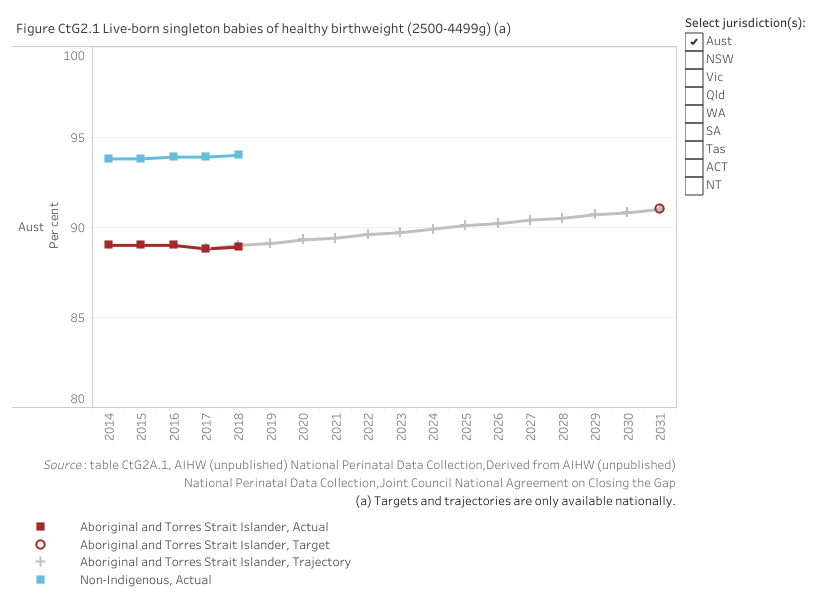TARGET 2
By 2031, increase the proportion of Aboriginal and Torres Strait Islander babies with a healthy birthweight to 91 per cent
Dashboard snapshot: The data below are the most recent at the time of preparing the July 2021 report. Please go to the dashboard to access the current data.
Nationally in 2018, 88.9 per cent of Aboriginal and Torres Strait Islander babies born were of a healthy birthweight (figure CtG2.1).
This is similar to 2017 (the baseline year).
Nationally, based on the most recent year of data (and taking into consideration the variability bands associated with the data) the target is on track to be met, subject to caveats (see the How to interpret data information).

The assessment below reflects progress from the baseline year to the current year (ie improvement or otherwise in the rate). This differs to the national assessment against the trajectory (above), which compares the current year rate to the rate on the target trajectory at the same time period.
Target data specifications
Outcome: | Aboriginal and Torres Strait Islander children are born healthy and strong. |
|---|---|
Target: | By 2031, increase the proportion of Aboriginal and Torres Strait Islander babies with a healthy birthweight to 91 per cent. |
Indicator: | The proportion of Aboriginal and Torres Strait Islander babies with a healthy birthweight. |
Measure: | The measure is defined as: Numerator — number of live born singleton Aboriginal and Torres Strait Islander babies who weighed between 2500 and 4499 grams at birth Denominator — total number of live born singleton Aboriginal and Torres Strait Islander babies and is presented as a percentage. |
Target established: | National Agreement on Closing the Gap July 2020 |
Latest dashboard update: | 23 June 2021 |
Indicator type: | Target |
Interpretation of change: | A high or increasing proportion is desirable. An increase from the baseline year is an improvement. |
Data source(s): | Name: AIHW National Perinatal Data Collection (NPDC) Frequency: Annual Documentation (links): https://www.aihw.gov.au/about-our-data/our-data-collections/national-perinatal-data-collection |
Data provider: | Provider name: Australian Institute of Health and Welfare Provider area: Perinatal |
Baseline year: | 2017 |
Target year: | 2031 |
Disaggregations: | State and territory and Australia, by Indigenous status of the baby, by birthweight range — low birthweight, healthy birthweight, and high birthweight. |
Computation: | Numerator divided by Denominator multiplied by 100 Counting rules Data relate to live births. Births both less than 20 weeks gestation and less than 400 grams birthweight are not included in the NPCD. Healthy birthweight is defined as babies who weighed between 2500 and 4499 grams at birth; low birthweight (less than 2500 grams); high birthweight (4500 grams and over). Data are by place of usual residence of the mother. Indigenous status is of the baby. Excludes (both numerator and denominator):
Supporting calculations Variability bands (provided for proportions). See the How to interpret data for further information: https://www.pc.gov.au/closing-the-gap-data/how-to/interpret-data. |
Data quality considerations: | In the NPDC, Indigenous status is a measure of whether a person identifies as being of Aboriginal and Torres Strait Islander origin. All jurisdictions have a data item to record Indigenous status of the mother and Indigenous status of the baby on their perinatal form, although there are some differences among the jurisdictions. The AIHW does not provide data for proportions based on denominators of less than 100 for reliability reasons. Proportions based on numerators of less than five are also not provided, with the exception of not stated categories. However, relevant data are included in the calculation for Australian totals. |
Future reporting: | Additional disaggregations required for future reporting:
|
Supporting indicators
Driver
- Proportion of mothers who smoke during pregnancy by age groups
Any time, or after 20 weeks - Proportion of mothers who consume alcohol during pregnancy by age groups
- Proportion of pregnant mothers with a pre-existing health condition
Gestational diabetes, obesity, hypertension, other - Use of antenatal care by pregnant women
• proportion with five or more antenatal visits
• proportion with at least one antenatal care visit in the first trimester - Proportion of pre-term births
Contextual information
- Progress towards parity
